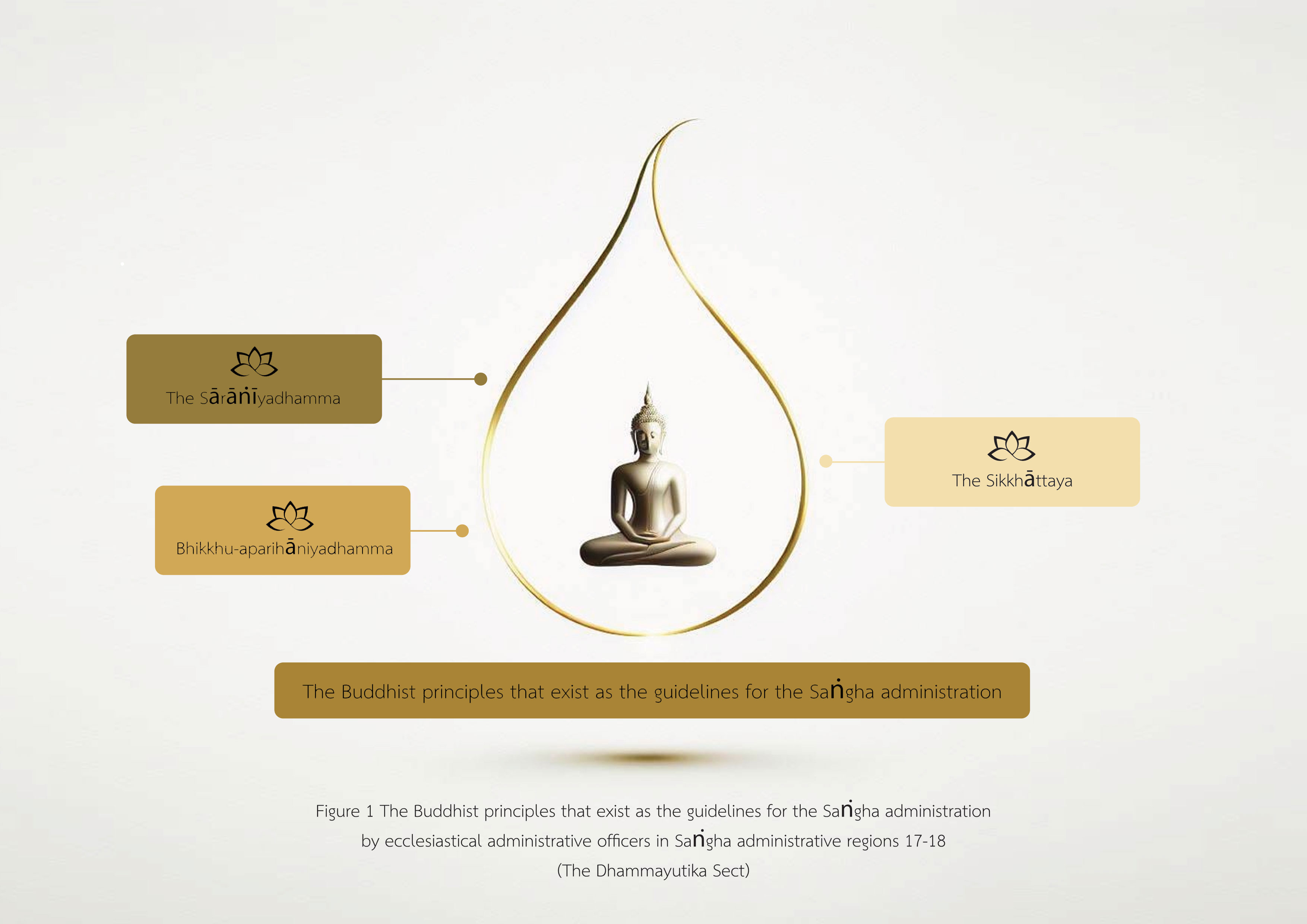GUIDELINES FOR RESOLVING THE SAṄGHA ADMINISTRATION BY ECCLESIASTICAL ADMINISTRATIVE OFFICERS IN SAṄGHA ADMINISTRATIVE REGIONS 17-18 (THE DHAMMAYUTIKA SECT)
Keywords:
Guidelines for Resolving, The Saṅgha Administration, Ecclesiastical Administrative Officers, Saṅgha Administrative Regions 17-18 (The Dhammayutika Sect)Abstract
Background and Objective: There is a diversity of ethnicities and religions in Saṅgha administrative regions 17 and 18 of the Dhammayutika Sect. The areas mentioned earlier have diversity in ethnicity, religion, and culture. Therefore, the Saṅgha administration in the mentioned areas has limits and differences from any general area. The administration in these areas requires ability, sacrifice, and administering skills from ecclesiastical administrative officers. This research aims to study the problems and guidelines for resolving the Saṅgha administration by ecclesiastical administrative officers in Saṅgha administrative regions 17-18 (The Dhammayutika Sect).
Methodology: In this mixed-method research, the population consisted of 194 ecclesiastical administrative officers in Saṅgha administrative regions 17-18 (The Dhammayutika Sect) and 5 key informants. The research tools comprised a questionnaire, a semi-structured interview form, and content analysis.
Main Results: The study of guidelines for resolving the Saṅgha administration by ecclesiastical administrative officers in Saṅgha administrative regions 17-18 (The Dhammayutika Sect) was divided into six aspects. The six aspects consisted of governance, Buddhist education, Buddhist propagation, public education, public assistance, and public welfare. The problems existed in all six aspects. For example, the problem in the governance aspect comprised the lack of cooperation among Buddhist monks, which caused communication and coordination of the Saṅgha Order to be deferred and held from the utmost efficiency. In the public education aspect, the ecclesiastical administrative officers and temples lacked preparation due to personnel shortages and a lack of knowledge in the matter of public education and the management of public education. The guidelines for resolving the Saṅgha administration suggested that the Saṅgha Order in Saṅgha administrative regions 17-18 should have regulated a clear and suitable policy for yearly development by conducting studies or providing guidelines. The Saṅgha Order was necessitated to announce rules and regulations of Buddhist temples. The guidelines also suggested, in terms of the Buddhist education aspect, that the Saṅgha Order required supervision for the education of Buddhist monks and novices by aiding with fundraising. Additionally, the Saṅgha Order should have created an associate network in the operations or brought government agencies, private sectors, civil society, and citizens together to participate in the Saṅgha administration to benefit the efficiency of Saṅgha administration.
Involvement to Buddhadhamma: The study of guidelines for resolving the Saṅgha administration by ecclesiastical administrative officers is the study within the characteristics of Applied Buddhism, which leads to using Buddhist principles as Buddhist innovations for the Saṅgha administration. The Buddhist principles in this innovation consisted of, firstly, the Bhikkhu-aparihāniyadhamma (Conditions of welfare) is the Buddhist principle for an administrative officer or executive to support the prosperity in the order. Next, the Sikkhāttaya (The Threefold Training) is fundamental in the educational aspect, which exists as the basis in the training of good behaviors to human. Finally, the Sārāṇīyadhamma (States of conciliation) is the influence for creating unity between the Saṅgha Order and lay people in order to drive forward the Saṅgha administration by ecclesiastical administrative officers in Saṅgha administrative regions 17-18 (The Dhammayutika Sect) with efficiency and effectiveness.
Conclusions: The problems and guidelines for resolving the Saṅgha administration by ecclesiastical administrative officers in Saṅgha administrative regions 17-18 (The Dhammayutika Sect) indicated that these problems and guidelines existed within the six aspects, which consisted of governance, Buddhist education, Buddhist propagation, public education, public assistance, and public welfare. These problems required urgent resolution to benefit the Saṅgha administration in Saṅgha administrative regions 17-18 (The Dhammayutika Sect).
References
Phramaha Jaran Bhurikovido. (2020). Guidelines for the Administration of Sangha Affairs Based on the Buddhist Integration of Sangha Administrators in Nonthaburi Province. Journal of Graduate Studies Review, 16(1), 104-117.
Sawetworrachot, T. (2019). Effectiveness of Dhammayuttika Nikaya Sangkha's Affairs Adiministratoin in Nakhon Si Thammarat Province. Panya, 26(2), 73-85.
Watthanachaiwanich, R. (2021). Administration of Sangha Affairs of the Sangha Administrative Monks in the Three Southern Border Provinces. Mahachulagajasara Journal, 12(1), 44-58.
Bunthong, P. (2018). The Sanggha Administration of the Sanggha in Southern Thailand. Journal of MCU Nakhondhat, 5(1), 30-44.
Sangha Act, B.E. 2505. (1962).
Phra Narong Sangkhawichit. (2017). Present Thai Sangha Administration: Problems and Suggested Solutions. Journal of MCU Social Science Review, 6(1), 27-40.
Sisabai, S. (2022). Sangha Law Division: Guidelines for the Establishment of the Sangha Aid Center on Law and Dispute for Strengthening Sangha Administration in Thai Society. Journal of MCU Social Science Review, 11(6), 301-314.
Phrakru Wimon Suwanakorn, Thong-in, T. & Phra Raphin Phutthisaro. (2016). The Desirable Model of Sangha Administration of Administrative Monks at the Sangha Administration Region 1. Journal of MCU Social Science Review, 5(2), 15-26.
Phra Methidhammapon. (1996). The Governance of the Thai Sangha. Bangkok, Thailand: SAHADHAMMIKA.
Phramaha Adisak Gavesako & Nuthongkaew, K. (2019). Effectiveness of Dhammayuttika Nikaya Sangkha's Affairs Adiministratoin in Nakhon Si Thammarat Province. Panya, 26(2), 73-85.

Downloads
Published
How to Cite
Issue
Section
License
Copyright (c) 2024 Journal of Buddhist Anthropology

This work is licensed under a Creative Commons Attribution-NonCommercial-NoDerivatives 4.0 International License.







